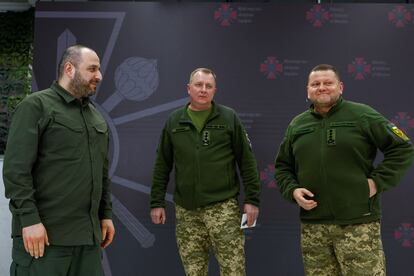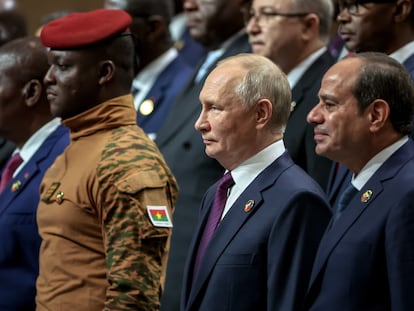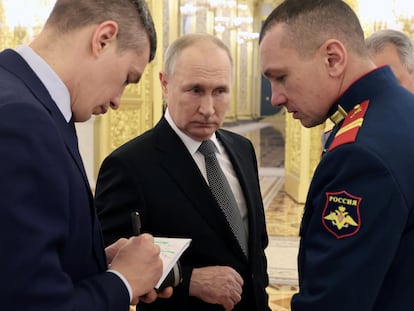Zaluzhnyi vs Zelenskiy: Ukrainian commander-in-chief challenges president over recruitment strategy
The general, who is becoming increasingly distant from Ukraine’s leader, claims to be dissatisfied with the offices in charge of mobilizing soldiers


The decision to recruit more soldiers and the strategy to achieve this goal has further distanced Valerii Zaluzhnyi, the commander-in-chief of the Armed Forces of Ukraine, from Ukrainian President Volodymyr Zelenskiy. General Zaluzhni challenged the Ukrainian leader on Tuesday by criticizing the government’s strategy to mobilize more troops to fight Russia’s full-scale invasion. “I am not satisfied with the work of the [recruitment offices],” Zaluzhni said at a rare press conference in Kyiv.
Russia’s war against Ukraine has become a battle of attrition, and as the fighting enters its third year, few Ukrainians want to go to the front lines. Meanwhile, in Russia, the Kremlin has ordered the maximum number of army personnel to be raised to 2.2 million.
In addition to criticizing the recruitment plan, Zaluzhni also expressed his concern for the situation in Ukraine. “I made a mistake believing that stopping the casualties we have caused would be a factor for Russia,” said the head of the Ukrainian Armed Forces.
This is the second time Zaluzhni and Zelenskiy have clashed in public. In a November interview with The Economist, the general admitted that the situation had reached a stalemate, that it was proving very difficult for Ukraine to advance and that the counteroffensive has collapsed. He also criticized the pace of recruitment as being too slow. The Ukrainian government censured Zaluzhni for his statements. Last week, Zelenskiy stressed that Zaluzhni — whose popularity has skyrocketed in recent months, while the president’s has fallen amid the failed counteroffensive — is also responsible for the results on the battlefield.
The latest public disagreement comes after Zelenskiy’s executive presented in the Rada, the Ukrainian Parliament, a decree aimed at boosting the number of soldiers in the army. The draft law — which will be debated and amended — expands the conditions of men who can be called up and reduces the minimum age of conscripts from 27 to 25. It only applies to men, as women enlist voluntarily.
Last week, at the annual press conference to review the situation in the country, Zelenskiy said that the army was seeking to mobilize between 450,000 and 500,000 new recruits, but stressed that the issue required further debate. However, Zaluzhni said on Tuesday that the figure only represents a general plan that would be covered gradually.
“I cannot say how many: it is a military secret,” the general said in the televised conference, detailing only that the number will take into account “the compensation for losses, the training of new units and the replacement of possible losses next year.” Zaluzhni also said that he is leaving the idea of recruiting Ukrainians abroad — an idea considered by the Ukrainian Ministry of Defense — in the hands of the government.
For Ukraine, increasing military personnel is a top priority. Kyiv has not made public how many troops it has in its forces — which are made up of several bodies — but experts estimate that there were one million at the beginning of the war. Since then, the Ukrainian army has suffered casualties. While Ukrainians rushed to enlist during the first stages of the war, today, few are eager to join. In most cities far from the battlefront, the war does not have the same impact. What’s more, corruption cases against recruitment officers, who received bribes in exchange for exempting people from service, have sparked widespread indignation, which has made it even more difficult to swell the army’s ranks.
On the Donbas front, in eastern Ukraine, the vast majority of soldiers have not taken leave to return home for months. Many are exhausted. “It gets very hard, the physical and mental fatigue is sometimes overwhelming,” admitted Kostya, a tank driver, in a coffee kiosk filled with military personnel, a few miles from the Bakhmut front, which is one of the most active.
Russia, meanwhile, has been digging in, completing robust defenses and continuing to launch waves of troops against the Ukrainian line in a bid to gain a few meters. Ukrainian analysts and military officials say Moscow is using its own soldiers as cannon fodder. Ukraine argues that only with new, more powerful and technologically superior weapons sent by its allies will it be able to turn the battle around.
But the EU — which is hoping to approve a special €50 billion ($55 billion) aid package to keep Ukraine afloat — is struggling to produce enough ammunition to keep up with Ukraine’s needs. What’s more, arms sent by EU countries to Ukraine have only just been meeting the country’s basic requirements. The United States is in a similar position. Washington’s $61.4 billion in funding for military and economic aid to Ukraine is blocked because of infighting, largely within the Republican Party.
Sign up for our weekly newsletter to get more English-language news coverage from EL PAÍS USA Edition
Tu suscripción se está usando en otro dispositivo
¿Quieres añadir otro usuario a tu suscripción?
Si continúas leyendo en este dispositivo, no se podrá leer en el otro.
FlechaTu suscripción se está usando en otro dispositivo y solo puedes acceder a EL PAÍS desde un dispositivo a la vez.
Si quieres compartir tu cuenta, cambia tu suscripción a la modalidad Premium, así podrás añadir otro usuario. Cada uno accederá con su propia cuenta de email, lo que os permitirá personalizar vuestra experiencia en EL PAÍS.
¿Tienes una suscripción de empresa? Accede aquí para contratar más cuentas.
En el caso de no saber quién está usando tu cuenta, te recomendamos cambiar tu contraseña aquí.
Si decides continuar compartiendo tu cuenta, este mensaje se mostrará en tu dispositivo y en el de la otra persona que está usando tu cuenta de forma indefinida, afectando a tu experiencia de lectura. Puedes consultar aquí los términos y condiciones de la suscripción digital.
More information
Archived In
Últimas noticias
Most viewed
- Oona Chaplin: ‘I told James Cameron that I was living in a treehouse and starting a permaculture project with a friend’
- Reinhard Genzel, Nobel laureate in physics: ‘One-minute videos will never give you the truth’
- Sinaloa Cartel war is taking its toll on Los Chapitos
- Why the price of coffee has skyrocketed: from Brazilian plantations to specialty coffee houses
- Silver prices are going crazy: This is what’s fueling the rally










































